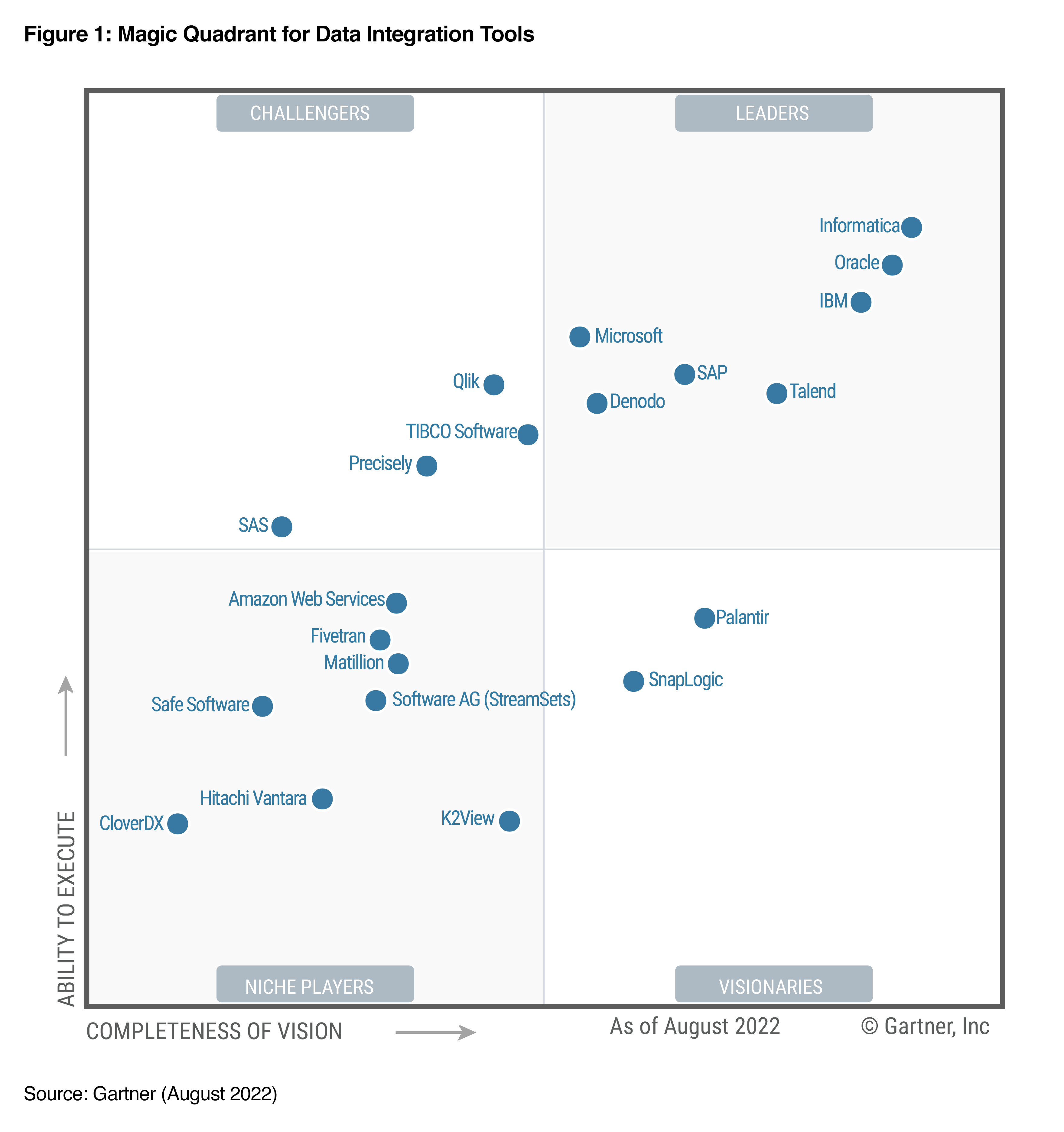We’re a Leader in the 2022 Gartner® Magic Quadrant™ for Data Integration Tools – for the 17th Time

I’m excited to share that Gartner has named Informatica a Leader in its 2022 Gartner® Magic Quadrant™ for Data Integration Tools for the seventeenth consecutive year – which is no easy feat in our opinion. Gartner evaluated 21 vendors and positioned Informatica furthest on the completeness of vision and highest for ability to execute axes.
This is a gratifying and proud moment for us at Informatica. We believe this is an acknowledgment of our proven track record as an independent and neutral data integration vendor and our commitment to innovation and customer-centricity. We believe this recognition reaffirms the trust Informatica customers place in us to help them build an intelligent data enterprise.
To put this recognition in context, let’s explore why data integration is critical for your business.
Why Data Integration Matters
Gartner defines data integration as “the discipline comprising the architectural patterns, methodologies, and tools that allow organizations to achieve consistent access and delivery of data across a wide spectrum of data sources and data types to meet the data consumption requirements of business applications and end users.”
The 2022 Gartner® Magic Quadrant™ for Data Integration Tools report states, “The data integration tools market is seeing renewed momentum driven by requirements for multicloud and hybrid data integration and data fabric patterns.”
In the report, Gartner shares four major use cases that most enterprises face today. “Below are the Gartner definitions of these use cases:
- Data engineering: The usage of data integration tool capabilities to engineer data pipelines in support of various analytical use cases such as data warehouse, data lakes, data science and machine learning.
- Cloud data integration: Migrating and modernizing data workloads in the public cloud with an architecture that spans on-premises and one or more cloud ecosystems (hybrid/multicloud) to enable an optimal use of cloud resources
- Operational data integration: Supporting operational/transactional data integration use cases such as master data management (MDM), interenterprise data acquisition and sharing, B2B data sharing, synchronizing data related to critical business processes, and supporting data governance initiatives.
- Data fabric: Data integration capabilities delivered in support of use cases related to the emerging data fabric design. This includes the ability to enable faster access to trusted data across distributed landscapes by utilizing active metadata, semantics and ML capabilities.”
We believe Informatica provides comprehensive and integrated capabilities across all these data integration use cases, and we continue to raise the bar through the following capabilities:
- Enable organizations to scale data engineering workloads with Advanced Serverless and CDI-Elastic based on Spark
- Automate cloud modernization initiatives and modernize data and analytics in the cloud by efficiently ingesting large amounts of data from various sources in a unified approach, without manual coding
- Accelerate data science and AI initiatives by operationalizing AI/ML models at scale
- Deliver a consistent experience across the development lifecycle with out-of-the-box CI/CD capabilities by removing data silos across development and operations
- Accelerate real digital transformation with enterprise-scale metadata management and metadata-driven intelligence and automation
Key Innovations of Informatica Data Integration Solutions
We innovate constantly in the data integration space with the industry’s first and only Intelligent Data Management Cloud platform (IDMC), powered by CLAIRE, our AI-powered metadata engine. With IDMC, we deliver solutions for data ingestion and streaming, data integration, data quality, data catalog and data governance to control costs, increase productivity and accelerate time to market with a single, comprehensive, cloud-native data integration and management platform.
Here are some of our key data integration innovations and strengths that we believe are helping customers become more data-driven to help them make better decisions and gain the insights they need to run their organizations more efficiently.
- Active metadata. Our platform enables organizations to use active metadata intelligence across the enterprise for automated and augmented data management. Organizations can also understand who is using the data, the quality of the data, where the data resides, and how it is moving through applications, systems, databases and other data sources.
- CLAIRE®. CLAIRE is our AI engine that powers intelligence and automation across our platform. CLAIRE’s AI algorithms automate tasks and data processes to deliver thousands of hours of time and cost savings for our customers.
- Low code / no code design environment. Our platform offers a low code / no code user interface that makes it quick and easy for both nontechnical and technical users to design data pipelines, build integrations, deploy data quality checks and quickly bring disparate data sources together to build a single source of truth, with minimal IT support.
- Single pane of glass. Our platform includes a comprehensive, holistic and integrated Operations Insights monitoring service that, when combined with our extensive data connector libraries, allows for comprehensive monitoring of all data management workloads operated on our platform. Data users and business leaders obtain an in-depth view of all data pipelines and data management operations across the enterprise, and a single pane view of the health of their data processes.
Next Steps
Find out more about our strengths. Download your complimentary copy of the 2022 Gartner® Magic Quadrant™ for Data Integration Tools now.
Gartner and Magic Quadrant are registered trademarks of Gartner, Inc. and/or its affiliates in the U.S. and internationally and are used herein with permission. All rights reserved.
Gartner does not endorse any vendor, product or service depicted in its research publications, and does not advise technology users to select only those vendors with the highest ratings or other designation. Gartner research publications consist of the opinions of Gartner's research organization and should not be construed as statements of fact. Gartner disclaims all warranties, expressed or implied, with respect to this research, including any warranties of merchantability or fitness for a particular purpose.
This graphic was published by Gartner, Inc. as part of a larger research document and should be evaluated in the context of the entire document. The Gartner document is available upon request from Informatica


May 31, 2023
May 31, 2023







